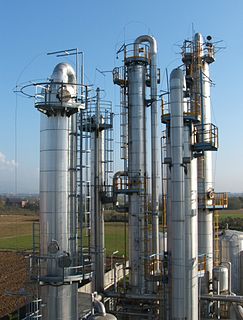
A valve is a device or natural object that regulates, directs or controls the flow of a fluid by opening, closing, or partially obstructing various passageways. Valves are technically fittings, but are usually discussed as a separate category. In an open valve, fluid flows in a direction from higher pressure to lower pressure. The word is derived from the Latin valva, the moving part of a door, in turn from volvere, to turn, roll.
Instrumentation is a collective term for measuring instruments that are used for indicating, measuring and recording physical quantities. The term has its origins in the art and science of scientific instrument-making.
An actuator is a component of a machine that is responsible for moving and controlling a mechanism or system, for example by opening a valve. In simple terms, it is a "mover".

Fluid power is the use of fluids under pressure to generate, control, and transmit power. Fluid power is subdivided into hydraulics using a liquid such as mineral oil or water, and pneumatics using a gas such as air or other gases. Compressed-air and water-pressure systems were once used to transmit power from a central source to industrial users over extended geographic areas; fluid power systems today are usually within a single building or mobile machine.

Hydraulic machines use liquid fluid power to perform work. Heavy construction vehicles are a common example. In this type of machine, hydraulic fluid is pumped to various hydraulic motors and hydraulic cylinders throughout the machine and becomes pressurized according to the resistance present. The fluid is controlled directly or automatically by control valves and distributed through hoses, tubes, or pipes.

A solenoid valve is an electromechanically operated valve.
The Ultradrive is an automatic transmission manufactured by Chrysler beginning in the 1989 model year.
A transmission control unit (TCU), also known as a transmission control module (TCM), or a gearbox control unit (GCU), is a type of automotive ECU that is used to control electronic automatic transmissions. Similar systems are used in conjunction with various semi-automatic transmissions, purely for clutch automation and actuation. A TCU in a modern automatic transmission generally uses sensors from the vehicle, as well as data provided by the engine control unit (ECU), to calculate how and when to change gears in the vehicle for optimum performance, fuel economy and shift quality.

SAMSON AG, founded in 1907 by Hermann Sandvoss, is a German corporation headquartered in Frankfurt. SAMSON is represented in over 40 countries with more than 4,500 employees and more than 50 subsidiaries, more than 200 engineering and service centers worldwide.
NeSSI is a global and open initiative sponsored by the Center for Process Analysis and Control (CPAC) at the University of Washington, in Seattle.
A shutdown valve is an actuated valve designed to stop the flow of a hazardous fluid upon the detection of a dangerous event. This provides protection against possible harm to people, equipment or the environment. Shutdown valves form part of a safety instrumented system. The process of providing automated safety protection upon the detection of a hazardous event is called functional safety.
Rotork plc is a British-based company manufacturing industrial flow control equipment. It is listed on the London Stock Exchange and is a constituent of the FTSE 250 Index.
Directional control valves (DCVs) are one of the most fundamental parts of hydraulic and pneumatic systems. DCVs allow fluid flow into different paths from one or more sources. DCVs will usually consist of a spool inside a cylinder which is mechanically or electrically actuated. The position of the spool restricts or permits flow, thus it controls the fluid flow.

Instrumentation is used to monitor and control the process plant in the oil, gas and petrochemical industries. Instrumentation ensures that the plant operates within defined parameters to produce materials of consistent quality and within the required specifications. It also ensures that the plant is operated safely and acts to correct out of tolerance operation and to automatically shut down the plant to prevent hazardous conditions from occurring. Instrumentation comprises sensor elements, signal transmitters, controllers, indicators and alarms, actuated valves, logic circuits and operator interfaces.

An automatic faucet or tap is a faucet equipped with a proximity sensor and mechanism that opens its valve to allow water to flow in response to the presence of a user's hands in close proximity. The faucet closes its valve again after a few seconds or when it no longer detects the presence of a user's hands.

Fluid Components International (FCI), headquartered in San Marcos, California, is a manufacturer of thermal dispersion flow and level measurement instrumentation. FCI has two divisions, one serving customers with measurement needs in industrial process and plant applications and an aerospace division, which produces level, temperature, flow and pressure sensors for aircraft manufacturers. FCI was a pioneer in developing thermal dispersion technology and holds numerous design and technology patents for its application in flow and level measurement.
Partial stroke testing is a technique used in a control system to allow the user to test a percentage of the possible failure modes of a shut down valve without the need to physically close the valve. PST is used to assist in determining that the safety function will operate on demand. PST is most often used on high integrity emergency shutdown valves (ESDVs) in applications where closing the valve will have a high cost burden yet proving the integrity of the valve is essential to maintaining a safe facility. In addition to ESDVs PST is also used on high integrity pressure protection systems or HIPPS. Partial stroke testing is not a replacement for the need to fully stroke valves as proof testing is still a mandatory requirement.

The first automatic timer, the dashpot timer has been used in many different machines and has many variations. Pneumatic, hydraulic-action, and mercury displacement timers. Being used in a variety of things such as printing presses, motors, and even irrigation systems, the dashpot timer has seen many applications. Even in modern times with electrical and digital timers, these old mechanical timers are still in use due to their simplicity and ability to function in tough environments.

A gas cabinet is a metallic enclosure which is used to provide local exhaust ventilation system for virtually all of the gases used or generated in the semiconductor, solar, MEMS, NANO, solar PV, manufacturing and other advanced technologies.

A Diving rebreather is an underwater breathing apparatus that absorbs the carbon dioxide of a diver's exhaled breath to permit the rebreathing (recycling) of the substantially unused oxygen content, and unused inert content when present, of each breath. Oxygen is added to replenish the amount metabolised by the diver. This differs from open-circuit breathing apparatus, where the exhaled gas is discharged directly into the environment. The purpose is to extend the breathing endurance of a limited gas supply, and, for covert military use by frogmen or observation of underwater life, to eliminate the bubbles produced by an open circuit system. A diving rebreather is generally understood to be a portable unit carried by the user, and is therefore a type of self-contained underwater breathing apparatus (scuba). A semi-closed rebreather carried by the diver may also be known as a gas extender. The same technology on a submersible or surface installation is more likely to be referred to as a life-support system.











